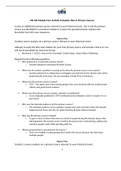Examen
BLS CPR EXAM QUESTIONS AND ANSWERS
- Grado
- Institución
Which of the following describes the proper sequences of BLS? A.) Pulse check, rescue breath, compression B.) Airway, breathing, compression C.) 1, 2, 3, 4, 5 D.) C - A - B - ANSWER D The pulse assessed in an adult cardiac arrest victim is called the ______ pulse? A.) Groin B.) Radial ...
[Mostrar más]






